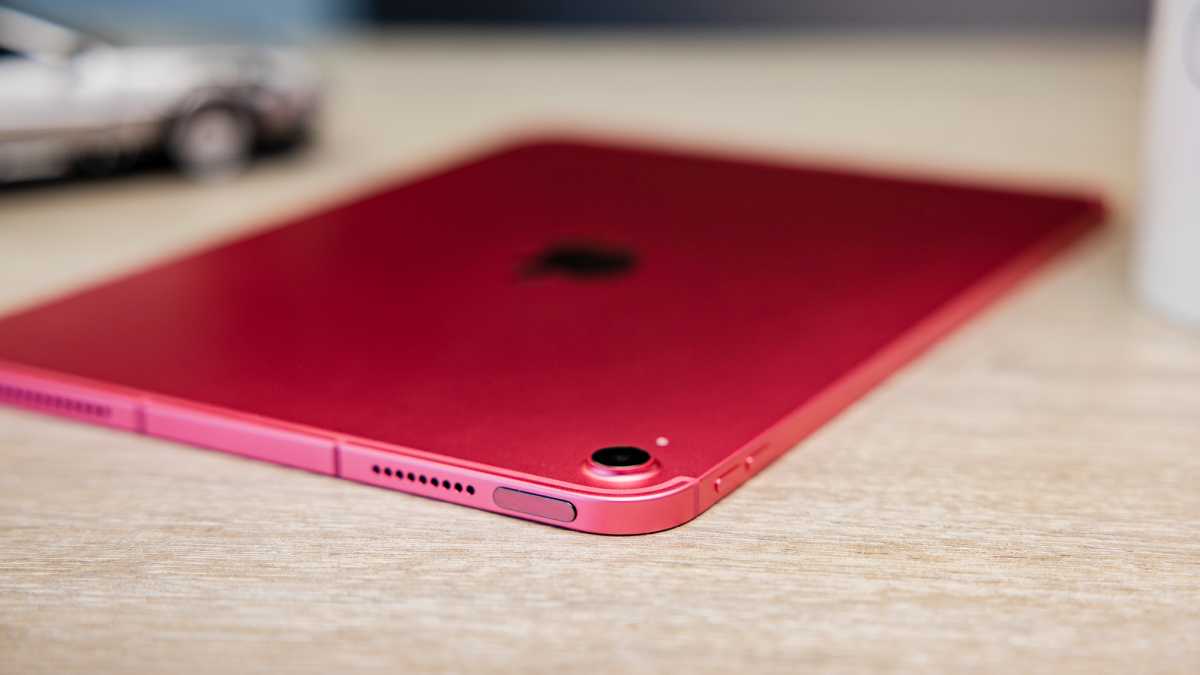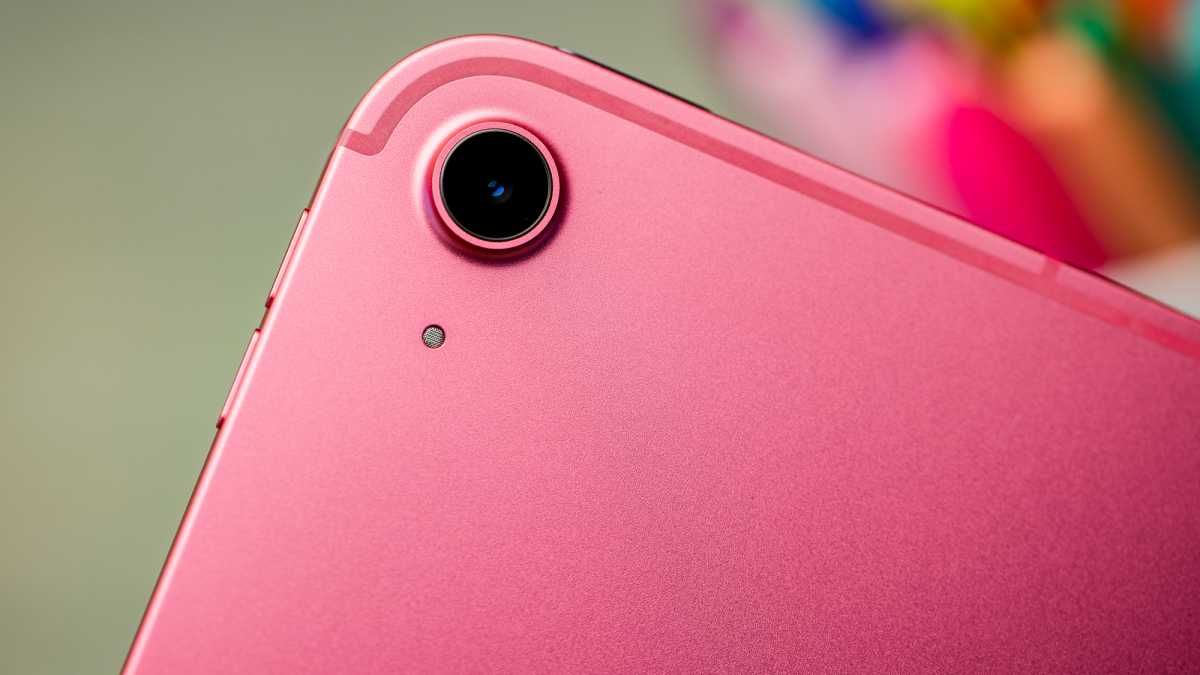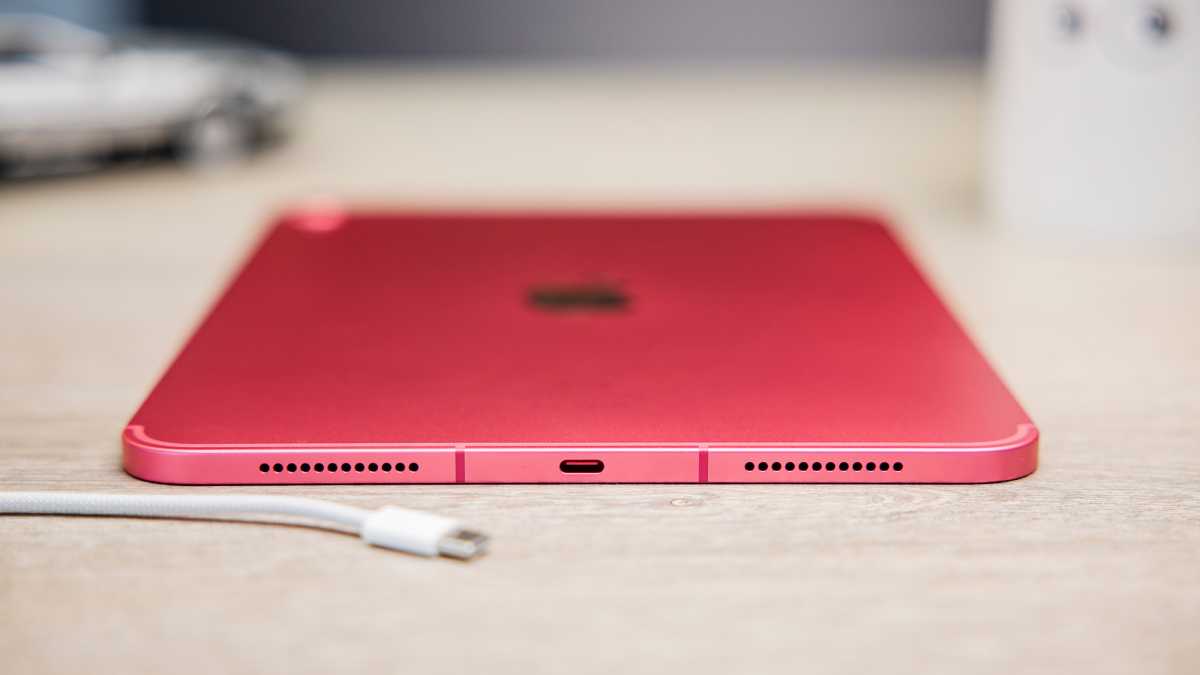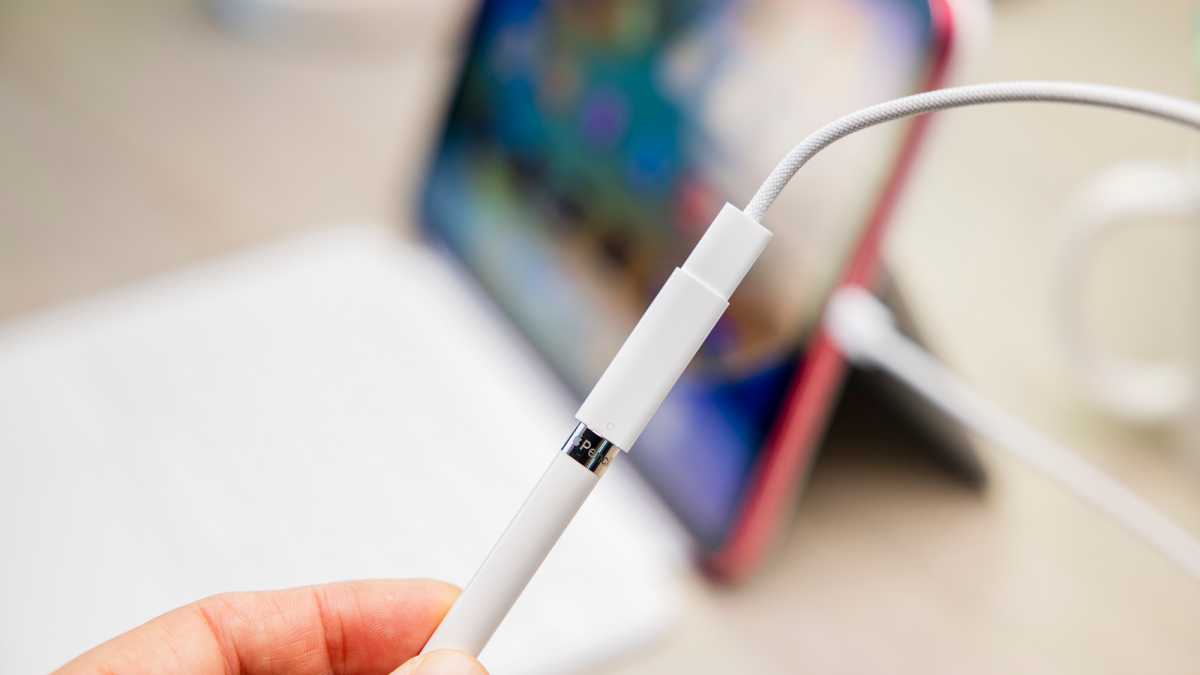Expert's Rating
Pros
- Much-improved cameras
- Beautiful color finishes
- Magic Keyboard Folio support
Cons
- Cheap-feeling unlaminated screen
- Disappointing battery life
- Bizarre Apple Pencil support
- No longer a budget tablet
Our Verdict
In many ways, the 10th-generation iPad is a fine tablet, with a stunning design, clever webcam, great cameras, and 5G… but those improvements come at a price, which means it’s no longer cheap enough for the budget market. Its two-year-old processor and unlaminated screen, meanwhile, mean it’s realistically not good enough for the mid-market.
Price When Reviewed
From $449
Best Prices Today: 10.9-inch iPad (2022)
It can be hard to get excited about the cheapest model in a range. Apple’s standard iPad has for years offered a blend of strong value and respectable specs without creating much of a buzz because the features it offers are either weaker than those on the Air, mini, and Pro models, or arrive several years later.
This latest iPad, however, may change that perception. It does some interesting things, particularly in terms of its position within the range–but not all of those things are good. Being interesting can be a mixed blessing.
Design and build: Bright, colorful, and modern
From very first impressions, it’s clear that Apple has given the humble iPad a glow-up. Particularly if you’ve got one of the bright new colors: I tested the pink model, which is vibrantly gorgeous in the flesh, but from publicity photos, the other colors look just as joyous. This is the first iPad in years to not offer even the choice of a black or dark-gray finish: your options are silver, pink, yellow, or blue–and these are much brighter shades than the comparatively somber blue, pink and purple offered with the latest iPad Air and mini. (In our iPad Air review I described its subtle purple hue as a “grown-up color.”)
There’s a temptation to look at these brash, unapologetic colors and compare them to the unloved iPhone 5c from 2013, which always seemed garish next to the understated elegance of the iPhone 5s. There’s clearly something to that analogy: Apple evidently thinks that bright colors are a property of budget devices, and that pro users are too sensible to work on a device that’s too flamboyant. But all I can say is that I disliked the iPhone 5c’s color options from the first moment I saw them, but was instantly blown away by my pink iPad. These are colors that are both bright and tasteful, and it seems a shame that buyers of the other iPad models don’t get them.
 https://b2c-contenthub.com/wp-content/uploads/2022/11/Apple-iPad-10-inch-2022-review_5.jpg?resize=300%2C168&quality=50&strip=all 300w, https://b2c-contenthub.com/wp-content/uploads/2022/11/Apple-iPad-10-inch-2022-review_5.jpg?resize=768%2C432&quality=50&strip=all 768w, https://b2c-contenthub.com/wp-content/uploads/2022/11/Apple-iPad-10-inch-2022-review_5.jpg?resize=1200%2C675&quality=50&strip=all 1200w, https://b2c-contenthub.com/wp-content/uploads/2022/11/Apple-iPad-10-inch-2022-review_5.jpg?resize=1536%2C864&quality=50&strip=all 1536w, https://b2c-contenthub.com/wp-content/uploads/2022/11/Apple-iPad-10-inch-2022-review_5.jpg?resize=1240%2C697&quality=50&strip=all 1240w, https://b2c-contenthub.com/wp-content/uploads/2022/11/Apple-iPad-10-inch-2022-review_5.jpg?resize=150%2C84&quality=50&strip=all 150w" width="1200" height="675" sizes="(max-width: 1200px) 100vw, 1200px" />
https://b2c-contenthub.com/wp-content/uploads/2022/11/Apple-iPad-10-inch-2022-review_5.jpg?resize=300%2C168&quality=50&strip=all 300w, https://b2c-contenthub.com/wp-content/uploads/2022/11/Apple-iPad-10-inch-2022-review_5.jpg?resize=768%2C432&quality=50&strip=all 768w, https://b2c-contenthub.com/wp-content/uploads/2022/11/Apple-iPad-10-inch-2022-review_5.jpg?resize=1200%2C675&quality=50&strip=all 1200w, https://b2c-contenthub.com/wp-content/uploads/2022/11/Apple-iPad-10-inch-2022-review_5.jpg?resize=1536%2C864&quality=50&strip=all 1536w, https://b2c-contenthub.com/wp-content/uploads/2022/11/Apple-iPad-10-inch-2022-review_5.jpg?resize=1240%2C697&quality=50&strip=all 1240w, https://b2c-contenthub.com/wp-content/uploads/2022/11/Apple-iPad-10-inch-2022-review_5.jpg?resize=150%2C84&quality=50&strip=all 150w" width="1200" height="675" sizes="(max-width: 1200px) 100vw, 1200px" />Dominik Tomaszewski / Foundry
Other than that, the iPad has seen a design overhaul that brings it in line with the iPad Air and mini. Most obviously, the Home button is gone and the Touch ID fingerprint sensor has been relocated to the power button on the top edge. On the iPad, I find this a superior position from an ergonomic point of view (the way you hold an iPhone, the Home button is easy to reach, but that was never the case with an iPad) but the narrower sensor makes it, in my experience, fractionally slower and less reliable at recognizing your fingerprint.
Screen: Bigger, but not really better
The departure of the Home button allows Apple to offer a larger screen without increasing the size of the case. Not significantly, anyway: the device’s width has gone up by 5mm, while the height/length has dropped by 2mm, and it’s fractionally thinner (7mm vs 7.5mm). The new iPad is a little lighter than last year’s model, too (1.06 pounds vs 1.09 pounds).
The screen is now up to 10.9 inches, which is the same size as that of the iPad Air; knowing Apple, that will likely jump up to 11 inches next year, while the iPad Pro gets bigger still. But for now, the iPad has parity. I can’t say I noticed the extra space but I definitely noticed and enjoyed the more modern look. It’s strange the way aesthetic fashions affect you, but the Home button design was definitely showing its age.
Some will be relieved, incidentally, that there’s no notch on the iPad. But the bezels around the edge of the screen are pretty wide and there’s plenty of space to fit in the front-facing camera without one.
 https://b2c-contenthub.com/wp-content/uploads/2022/11/Apple-iPad-10-inch-2022-review.jpg?resize=300%2C168&quality=50&strip=all 300w, https://b2c-contenthub.com/wp-content/uploads/2022/11/Apple-iPad-10-inch-2022-review.jpg?resize=768%2C432&quality=50&strip=all 768w, https://b2c-contenthub.com/wp-content/uploads/2022/11/Apple-iPad-10-inch-2022-review.jpg?resize=1200%2C675&quality=50&strip=all 1200w, https://b2c-contenthub.com/wp-content/uploads/2022/11/Apple-iPad-10-inch-2022-review.jpg?resize=1536%2C864&quality=50&strip=all 1536w, https://b2c-contenthub.com/wp-content/uploads/2022/11/Apple-iPad-10-inch-2022-review.jpg?resize=1240%2C697&quality=50&strip=all 1240w, https://b2c-contenthub.com/wp-content/uploads/2022/11/Apple-iPad-10-inch-2022-review.jpg?resize=150%2C84&quality=50&strip=all 150w" width="1200" height="675" sizes="(max-width: 1200px) 100vw, 1200px" />
https://b2c-contenthub.com/wp-content/uploads/2022/11/Apple-iPad-10-inch-2022-review.jpg?resize=300%2C168&quality=50&strip=all 300w, https://b2c-contenthub.com/wp-content/uploads/2022/11/Apple-iPad-10-inch-2022-review.jpg?resize=768%2C432&quality=50&strip=all 768w, https://b2c-contenthub.com/wp-content/uploads/2022/11/Apple-iPad-10-inch-2022-review.jpg?resize=1200%2C675&quality=50&strip=all 1200w, https://b2c-contenthub.com/wp-content/uploads/2022/11/Apple-iPad-10-inch-2022-review.jpg?resize=1536%2C864&quality=50&strip=all 1536w, https://b2c-contenthub.com/wp-content/uploads/2022/11/Apple-iPad-10-inch-2022-review.jpg?resize=1240%2C697&quality=50&strip=all 1240w, https://b2c-contenthub.com/wp-content/uploads/2022/11/Apple-iPad-10-inch-2022-review.jpg?resize=150%2C84&quality=50&strip=all 150w" width="1200" height="675" sizes="(max-width: 1200px) 100vw, 1200px" />Dominik Tomaszewski / Foundry
It may be bigger, but the display still isn’t laminated, which means I have to talk about this perennial bugbear yet again. The iPads mini, Air, and Pro all have laminated screens, which means the glass sits perfectly flat against the display elements underneath. The standard iPad’s screen, on the other hand, has a tiny but noticeable gap between the two. This means that when you press down on it, there’s a very slight give as it yields downwards.
Many people use unlaminated screens without being bothered by them, but once you’ve tried a laminated one, the alternative will feel cheap and plasticky by comparison. It’s disappointing that Apple is still cutting corners in this one area, which is especially annoying because I was so conscious of it so much of the time. Taps and swipes lie at the very core of the iPad experience, and to be reminded that you’re using a compromised model every time you do these fundamental actions is disheartening.
A more minor quibble with the unlaminated screen is the fact that it also affects performance when drawing or writing with an Apple Pencil, which is visibly further away from the line it’s making than would be the case with other iPads. We’re talking a matter of millimeters, though, so this isn’t a dealbreaker.
Also note that the iPad doesn’t have ProMotion, the Apple tech that gives iPad Pro screens both higher refresh rates and the ability to adjust those rates on the fly to conserve battery life. This was never going to happen, since even the iPad Air doesn’t get the feature, but it’s worth bearing in mind that ProMotion screens deliver a smoother experience with the Apple Pencil as well as for video and animation.
Cameras: Changes and improvements galore
Apple has upgraded the iPad’s rear camera from 8MP to 12MP, so it now matches the front-facing camera. It also gains a larger aperture (f/1.8, up from f/2.4), 4K video recording, and support for the third version of Smart HDR, while the previous model doesn’t support Smart HDR at all.
 https://b2c-contenthub.com/wp-content/uploads/2022/11/Apple-iPad-10-inch-2022-review_9.jpg?resize=300%2C168&quality=50&strip=all 300w, https://b2c-contenthub.com/wp-content/uploads/2022/11/Apple-iPad-10-inch-2022-review_9.jpg?resize=768%2C432&quality=50&strip=all 768w, https://b2c-contenthub.com/wp-content/uploads/2022/11/Apple-iPad-10-inch-2022-review_9.jpg?resize=1200%2C675&quality=50&strip=all 1200w, https://b2c-contenthub.com/wp-content/uploads/2022/11/Apple-iPad-10-inch-2022-review_9.jpg?resize=1536%2C864&quality=50&strip=all 1536w, https://b2c-contenthub.com/wp-content/uploads/2022/11/Apple-iPad-10-inch-2022-review_9.jpg?resize=1240%2C697&quality=50&strip=all 1240w, https://b2c-contenthub.com/wp-content/uploads/2022/11/Apple-iPad-10-inch-2022-review_9.jpg?resize=150%2C84&quality=50&strip=all 150w" width="1200" height="675" sizes="(max-width: 1200px) 100vw, 1200px" />
https://b2c-contenthub.com/wp-content/uploads/2022/11/Apple-iPad-10-inch-2022-review_9.jpg?resize=300%2C168&quality=50&strip=all 300w, https://b2c-contenthub.com/wp-content/uploads/2022/11/Apple-iPad-10-inch-2022-review_9.jpg?resize=768%2C432&quality=50&strip=all 768w, https://b2c-contenthub.com/wp-content/uploads/2022/11/Apple-iPad-10-inch-2022-review_9.jpg?resize=1200%2C675&quality=50&strip=all 1200w, https://b2c-contenthub.com/wp-content/uploads/2022/11/Apple-iPad-10-inch-2022-review_9.jpg?resize=1536%2C864&quality=50&strip=all 1536w, https://b2c-contenthub.com/wp-content/uploads/2022/11/Apple-iPad-10-inch-2022-review_9.jpg?resize=1240%2C697&quality=50&strip=all 1240w, https://b2c-contenthub.com/wp-content/uploads/2022/11/Apple-iPad-10-inch-2022-review_9.jpg?resize=150%2C84&quality=50&strip=all 150w" width="1200" height="675" sizes="(max-width: 1200px) 100vw, 1200px" />Dominik Tomaszewski / Foundry
Smart HDR is Apple’s clever AI tech for simultaneously capturing multiple different exposures in challenging lighting, then blending parts of each to deliver better image quality. It’s a godsend when shooting shaded subjects against a bright background, for example. As usual with the standard iPad, you’re making a compromise here since Apple’s top-tier devices have moved on to Smart HDR 4, but it’s still far better than the camera on a tablet has any right to be.
Even when shooting directly into a bright morning sun, the iPad’s rear camera was able to pick out detail and capture accurate color on foreground objects. And in less demanding lighting, photos were superb: clear, vibrant, and richly detailed. It’s likely to be the best camera that most people will never use.
The all-important front camera, meanwhile, gets significant changes of its own. Most obviously, it’s moved and now sits in the middle of the long edge with the volume keys. This is genuine galaxy-brain thinking, recognizing that a tablet’s most important camera duty is video calls in landscape mode, and ensures that you get a far better angle for such conversations: it’s simply more natural to talk without having to think about the location of the camera.
 https://b2c-contenthub.com/wp-content/uploads/2022/11/Apple-iPad-10-inch-2022-review_29.jpg?resize=300%2C168&quality=50&strip=all 300w, https://b2c-contenthub.com/wp-content/uploads/2022/11/Apple-iPad-10-inch-2022-review_29.jpg?resize=768%2C432&quality=50&strip=all 768w, https://b2c-contenthub.com/wp-content/uploads/2022/11/Apple-iPad-10-inch-2022-review_29.jpg?resize=1200%2C675&quality=50&strip=all 1200w, https://b2c-contenthub.com/wp-content/uploads/2022/11/Apple-iPad-10-inch-2022-review_29.jpg?resize=1536%2C864&quality=50&strip=all 1536w, https://b2c-contenthub.com/wp-content/uploads/2022/11/Apple-iPad-10-inch-2022-review_29.jpg?resize=1240%2C697&quality=50&strip=all 1240w, https://b2c-contenthub.com/wp-content/uploads/2022/11/Apple-iPad-10-inch-2022-review_29.jpg?resize=150%2C84&quality=50&strip=all 150w" width="1200" height="675" sizes="(max-width: 1200px) 100vw, 1200px" />
https://b2c-contenthub.com/wp-content/uploads/2022/11/Apple-iPad-10-inch-2022-review_29.jpg?resize=300%2C168&quality=50&strip=all 300w, https://b2c-contenthub.com/wp-content/uploads/2022/11/Apple-iPad-10-inch-2022-review_29.jpg?resize=768%2C432&quality=50&strip=all 768w, https://b2c-contenthub.com/wp-content/uploads/2022/11/Apple-iPad-10-inch-2022-review_29.jpg?resize=1200%2C675&quality=50&strip=all 1200w, https://b2c-contenthub.com/wp-content/uploads/2022/11/Apple-iPad-10-inch-2022-review_29.jpg?resize=1536%2C864&quality=50&strip=all 1536w, https://b2c-contenthub.com/wp-content/uploads/2022/11/Apple-iPad-10-inch-2022-review_29.jpg?resize=1240%2C697&quality=50&strip=all 1240w, https://b2c-contenthub.com/wp-content/uploads/2022/11/Apple-iPad-10-inch-2022-review_29.jpg?resize=150%2C84&quality=50&strip=all 150w" width="1200" height="675" sizes="(max-width: 1200px) 100vw, 1200px" />Dominik Tomaszewski / Foundry
The payoff, of course, is that you get bad angles when using the iPad in portrait mode, so selfies may suffer. (In fact, it’s not just the angle that’s a problem: for right-handed users the camera is exactly where your thumb will go to press the exposure button. Righties should remember to turn the iPad ‘upside down’ before shooting selfies to solve this issue.)
Despite the downsides, I love this change, and it’s about time. Apple has long been the only mainstream tablet maker refusing to properly position the camera in landscape orientation. But I wonder if everyone at Apple agrees—because for once, the standard iPad is the first member of the range to get this new feature. Perhaps it’s viewed as a risk, and this is an experiment. Or perhaps Apple has research that shows expensive iPads are used for selfies more than cheap ones. Who knows?
The front camera also gets Smart HDR 3, and I found that I could take a selfie with the sun behind me without losing the definition on the face. The angle was awkward, but the image quality (considering the conditions) was impressive.
 https://b2c-contenthub.com/wp-content/uploads/2022/11/iPad-2022-review-selfie-photo-test.jpg?resize=225%2C300&quality=50&strip=all 225w, https://b2c-contenthub.com/wp-content/uploads/2022/11/iPad-2022-review-selfie-photo-test.jpg?resize=768%2C1024&quality=50&strip=all 768w, https://b2c-contenthub.com/wp-content/uploads/2022/11/iPad-2022-review-selfie-photo-test.jpg?resize=900%2C1200&quality=50&strip=all 900w, https://b2c-contenthub.com/wp-content/uploads/2022/11/iPad-2022-review-selfie-photo-test.jpg?resize=1152%2C1536&quality=50&strip=all 1152w, https://b2c-contenthub.com/wp-content/uploads/2022/11/iPad-2022-review-selfie-photo-test.jpg?resize=1536%2C2048&quality=50&strip=all 1536w" width="900" height="1200" sizes="(max-width: 900px) 100vw, 900px" />
https://b2c-contenthub.com/wp-content/uploads/2022/11/iPad-2022-review-selfie-photo-test.jpg?resize=225%2C300&quality=50&strip=all 225w, https://b2c-contenthub.com/wp-content/uploads/2022/11/iPad-2022-review-selfie-photo-test.jpg?resize=768%2C1024&quality=50&strip=all 768w, https://b2c-contenthub.com/wp-content/uploads/2022/11/iPad-2022-review-selfie-photo-test.jpg?resize=900%2C1200&quality=50&strip=all 900w, https://b2c-contenthub.com/wp-content/uploads/2022/11/iPad-2022-review-selfie-photo-test.jpg?resize=1152%2C1536&quality=50&strip=all 1152w, https://b2c-contenthub.com/wp-content/uploads/2022/11/iPad-2022-review-selfie-photo-test.jpg?resize=1536%2C2048&quality=50&strip=all 1536w" width="900" height="1200" sizes="(max-width: 900px) 100vw, 900px" />Foundry
Speed tests: Fast but not future-proofed
The new iPad gets a new processor, but we should probably put an asterisk next to the word “new.” It’s the A14 Bionic: an upgrade from the A13 in last year’s iPad, certainly, but a chip that’s been around for two years. For comparison, the current iPad mini (which itself is a year old) has the A15, while the Air and Pro have moved on to M-class Mac processors.
In other words, the brand-new 2022 iPad is the slowest iPad Apple sells, with the sole exception of its immediate predecessor. That doesn’t mean it’s objectively slow–it was slick and responsive in testing, and ran every app I threw at it with no worries at all–but it does mean there’s less future-proofing.
This was all borne out in speed tests. The 10th-gen iPad scored 4,175 in the multi-core component of Geekbench 5, for example, which is a solid 20% improvement on the 3,480 scored by last year’s iPad but far behind the iPad Air’s 7,264. In other areas, Apple is clearly trying to lift the iPad out of its budget origins, but for theoretical speed and processor future-proofing, it’s still very much in that category.
It’s a similar tale for graphics power, with the iPad outscoring last year’s model by 16 percent in the 3DMark Wild Life Unlimited benchmark but lagging behind the iPad Air by a much bigger margin. Again, this is a perfectly decent iPad for gaming right now, but that won’t remain the case forever, and it will start to struggle with the most processor-intensive games a year or two earlier than the Air.
Battery life: Not great, not terrible
The iPad features a 28.6Wh battery, which Apple claims is good for up to 10 hours of web surfing on Wi-Fi, or nine hours on cellular data if that applies. That’s a standard claim, mind you: Apple says exactly the same thing about the iPad from 2021 (despite featuring a larger 32.4Wh battery), the iPad Air from this year (28.6Wh again), and even the latest models of the iPad mini (19.3Wh) and 12.9-inch iPad Pro (40.88Wh!). Apple simply expects iPads to last for 10 hours.
For a more precise assessment, we turned to the Geekbench 4 battery test, in which the iPad lasted just six hours and 13 minutes.
This isn’t as bad as it sounds, since real-world usage will be far less demanding; you can expect much longer life when using your iPad for writing documents, checking email, light gaming, and, as in Apple’s claim, browsing the web over Wi-Fi. Rather than a prediction of battery life in everyday use (which is messy and unpredictable), the test is designed to provide a rigorous and consistent point of comparison with other devices. It’s a worst-case scenario, but it’s fair.
The iPad Air, for example, fell short of the 10-hour mark too–although at seven hours and 28 minutes it came closer. The ninth-gen iPad, meanwhile, lasted eight hours and five minutes. In fact, none of the mid-size iPads we’ve tested over the past two years have hit the 10-hour mark in Geekbench 4, but all have lasted longer (by a clear hour or more) than the 10th-gen iPad.
This is clearly a disappointing performance, although subjective experience suggests it’s not disastrous. In general testing, the iPad consistently lasted throughout the day, which is the key threshold for battery success or failure. When using it as a laptop replacement, it happily and repeatedly reached logging-off time without dropping below 20 percent (or in most cases getting even close to it). The device simply seems to have issues coping with processor-intensive activities, with the 3DMark benchmarking session mentioned above triggering an alarming dip in power levels.
Overall I’d describe the iPad’s battery performance as okay. It’s good for light use but runs out quickly when you push the processor to its limits.
Charging and data transfers: Lightning no more
When topping up your iPad’s battery after a strenuous benchmarking session, you’ll both gain the benefits and suffer the downsides of Apple finally completing the migration of its tablet range to USB-C. (The iPad Pro ditched Lightning years ago, and the Air and mini followed more recently; the vanilla iPad is as usual the last to join the party.)
 https://b2c-contenthub.com/wp-content/uploads/2022/11/Apple-iPad-10-inch-2022-review_2.jpg?resize=300%2C168&quality=50&strip=all 300w, https://b2c-contenthub.com/wp-content/uploads/2022/11/Apple-iPad-10-inch-2022-review_2.jpg?resize=768%2C432&quality=50&strip=all 768w, https://b2c-contenthub.com/wp-content/uploads/2022/11/Apple-iPad-10-inch-2022-review_2.jpg?resize=1200%2C675&quality=50&strip=all 1200w, https://b2c-contenthub.com/wp-content/uploads/2022/11/Apple-iPad-10-inch-2022-review_2.jpg?resize=1536%2C864&quality=50&strip=all 1536w, https://b2c-contenthub.com/wp-content/uploads/2022/11/Apple-iPad-10-inch-2022-review_2.jpg?resize=1240%2C697&quality=50&strip=all 1240w, https://b2c-contenthub.com/wp-content/uploads/2022/11/Apple-iPad-10-inch-2022-review_2.jpg?resize=150%2C84&quality=50&strip=all 150w" width="1200" height="675" sizes="(max-width: 1200px) 100vw, 1200px" />
https://b2c-contenthub.com/wp-content/uploads/2022/11/Apple-iPad-10-inch-2022-review_2.jpg?resize=300%2C168&quality=50&strip=all 300w, https://b2c-contenthub.com/wp-content/uploads/2022/11/Apple-iPad-10-inch-2022-review_2.jpg?resize=768%2C432&quality=50&strip=all 768w, https://b2c-contenthub.com/wp-content/uploads/2022/11/Apple-iPad-10-inch-2022-review_2.jpg?resize=1200%2C675&quality=50&strip=all 1200w, https://b2c-contenthub.com/wp-content/uploads/2022/11/Apple-iPad-10-inch-2022-review_2.jpg?resize=1536%2C864&quality=50&strip=all 1536w, https://b2c-contenthub.com/wp-content/uploads/2022/11/Apple-iPad-10-inch-2022-review_2.jpg?resize=1240%2C697&quality=50&strip=all 1240w, https://b2c-contenthub.com/wp-content/uploads/2022/11/Apple-iPad-10-inch-2022-review_2.jpg?resize=150%2C84&quality=50&strip=all 150w" width="1200" height="675" sizes="(max-width: 1200px) 100vw, 1200px" />Dominik Tomaszewski / Foundry
On the plus side, USB-C supports a higher power delivery rate than Lightning. Of course, the actual speed at which your iPad charges is also dependent on other factors, such as the power adapter and the device’s own capabilities, so don’t expect a sudden transformation. Charging from empty using the bundled adapter and cable for 30 minutes lifted the iPad to 27 percent, and it reached 53 percent after a full hour. That’s decent speed (last year’s iPad managed only 19 percent in 30 minutes) but you should still budget a couple of hours for a complete charge.
USB-C is capable of faster data transfer than Lighting too, though Apple hasn’t unlocked more than USB 2.0 speeds here. Granted, high-speed transfers aren’t really the target audience for Apple’s cheapest model, so if that’s your priority you should be looking at the iPad Pro with its support for Thunderbolt/USB 4. Apple’s use of a non-proprietary standard will also make it easier and cheaper for third parties to sell compatible accessories.
But on the negative side, Apple switching to USB-C will make many of your existing iPad accessories redundant, unless you’re willing to bear the expense and/or inconvenience of dongles. And this includes, bafflingly, Apple’s own first-gen Apple Pencil, which is the only model the new iPad supports. (You can’t use the excellent second-gen Pencil, even though that came out in 2018.) The first Apple Pencil, you will recall, charges by plugging directly and precariously into the Lightning port of its companion iPad, a method which is now impossible, so Apple has released a cheap but easily lost dongle which is required for pairing as well as for charging the stylus.
 https://b2c-contenthub.com/wp-content/uploads/2022/11/Apple-iPad-10-inch-2022-review_26.jpg?resize=300%2C168&quality=50&strip=all 300w, https://b2c-contenthub.com/wp-content/uploads/2022/11/Apple-iPad-10-inch-2022-review_26.jpg?resize=768%2C432&quality=50&strip=all 768w, https://b2c-contenthub.com/wp-content/uploads/2022/11/Apple-iPad-10-inch-2022-review_26.jpg?resize=1200%2C675&quality=50&strip=all 1200w, https://b2c-contenthub.com/wp-content/uploads/2022/11/Apple-iPad-10-inch-2022-review_26.jpg?resize=1536%2C864&quality=50&strip=all 1536w, https://b2c-contenthub.com/wp-content/uploads/2022/11/Apple-iPad-10-inch-2022-review_26.jpg?resize=1240%2C697&quality=50&strip=all 1240w, https://b2c-contenthub.com/wp-content/uploads/2022/11/Apple-iPad-10-inch-2022-review_26.jpg?resize=150%2C84&quality=50&strip=all 150w" width="1200" height="675" sizes="(max-width: 1200px) 100vw, 1200px" />
https://b2c-contenthub.com/wp-content/uploads/2022/11/Apple-iPad-10-inch-2022-review_26.jpg?resize=300%2C168&quality=50&strip=all 300w, https://b2c-contenthub.com/wp-content/uploads/2022/11/Apple-iPad-10-inch-2022-review_26.jpg?resize=768%2C432&quality=50&strip=all 768w, https://b2c-contenthub.com/wp-content/uploads/2022/11/Apple-iPad-10-inch-2022-review_26.jpg?resize=1200%2C675&quality=50&strip=all 1200w, https://b2c-contenthub.com/wp-content/uploads/2022/11/Apple-iPad-10-inch-2022-review_26.jpg?resize=1536%2C864&quality=50&strip=all 1536w, https://b2c-contenthub.com/wp-content/uploads/2022/11/Apple-iPad-10-inch-2022-review_26.jpg?resize=1240%2C697&quality=50&strip=all 1240w, https://b2c-contenthub.com/wp-content/uploads/2022/11/Apple-iPad-10-inch-2022-review_26.jpg?resize=150%2C84&quality=50&strip=all 150w" width="1200" height="675" sizes="(max-width: 1200px) 100vw, 1200px" />Dominik Tomaszewski / Foundry
Tech fans are used to accessory obsolescence, and we knew our Lightning cables would be consigned to the drawer of oblivion at some point. But the way Apple has dealt with the Apple Pencil here is astonishing: now was surely the time to extend an olive branch and build in support for the 2nd-gen Pencil. Chuck in the slightly weaker stylus performance you get because of the unlaminated, non-ProMotion screen, and I have to advise against buying this iPad if you’re planning to use it with an Apple Pencil.
Joining the Magic circle
There is some more positive news on the accessories front, however. This year the standard iPad gets its own keyboard accessory in Apple’s excellent Magic Keyboard Folio. The key feature here is the trackpad, which enables the iPad to act as a far more plausible laptop replacement than was the case with the older Smart Keyboard.
In the past, there have always been caveats and stumbling blocks when trying to use an iPad as a laptop. For sure, it was possible to work effectively using the Smart Keyboard; you just had to memorize the key shortcuts and build up muscle memory. But it was a thing you had to devote time to learning. With the Magic Keyboard Folio, you just open the iPad and start working on it as if it was a laptop because it basically is a laptop. Apple has removed the friction.
 https://b2c-contenthub.com/wp-content/uploads/2022/11/Apple-iPad-10-inch-2022-review_22.jpg?resize=300%2C168&quality=50&strip=all 300w, https://b2c-contenthub.com/wp-content/uploads/2022/11/Apple-iPad-10-inch-2022-review_22.jpg?resize=768%2C432&quality=50&strip=all 768w, https://b2c-contenthub.com/wp-content/uploads/2022/11/Apple-iPad-10-inch-2022-review_22.jpg?resize=1200%2C675&quality=50&strip=all 1200w, https://b2c-contenthub.com/wp-content/uploads/2022/11/Apple-iPad-10-inch-2022-review_22.jpg?resize=1536%2C864&quality=50&strip=all 1536w, https://b2c-contenthub.com/wp-content/uploads/2022/11/Apple-iPad-10-inch-2022-review_22.jpg?resize=1240%2C697&quality=50&strip=all 1240w, https://b2c-contenthub.com/wp-content/uploads/2022/11/Apple-iPad-10-inch-2022-review_22.jpg?resize=150%2C84&quality=50&strip=all 150w" width="1200" height="675" sizes="(max-width: 1200px) 100vw, 1200px" />
https://b2c-contenthub.com/wp-content/uploads/2022/11/Apple-iPad-10-inch-2022-review_22.jpg?resize=300%2C168&quality=50&strip=all 300w, https://b2c-contenthub.com/wp-content/uploads/2022/11/Apple-iPad-10-inch-2022-review_22.jpg?resize=768%2C432&quality=50&strip=all 768w, https://b2c-contenthub.com/wp-content/uploads/2022/11/Apple-iPad-10-inch-2022-review_22.jpg?resize=1200%2C675&quality=50&strip=all 1200w, https://b2c-contenthub.com/wp-content/uploads/2022/11/Apple-iPad-10-inch-2022-review_22.jpg?resize=1536%2C864&quality=50&strip=all 1536w, https://b2c-contenthub.com/wp-content/uploads/2022/11/Apple-iPad-10-inch-2022-review_22.jpg?resize=1240%2C697&quality=50&strip=all 1240w, https://b2c-contenthub.com/wp-content/uploads/2022/11/Apple-iPad-10-inch-2022-review_22.jpg?resize=150%2C84&quality=50&strip=all 150w" width="1200" height="675" sizes="(max-width: 1200px) 100vw, 1200px" />Dominik Tomaszewski / Foundry
However, there are still some hurdles to clear. At $249, the keyboard is expensive (though not quite as expensive as the Magic Keyboard) and makes the iPad less portable. But it’s a transformative accessory.
Should you buy the 10th-gen iPad?
In many ways, this is a fine tablet, with a stunning design and a clever webcam that’s perfect for video calls. It boasts lots of significant upgrades over the previous model, from a larger screen and better cameras to a faster chip, and 5G… but those improvements come at a price—one so steep (from $329 to $449) that I would no longer view this as a budget tablet.
This is a shame because Apple already has a mid-market iPad: the iPad Air, which has a better screen, a much more future-proofed processor, and support for the second-gen Apple Pencil, yet is only $150 more. Rather than competing with the Air, the standard iPad existed to provide an affordable entry point and to appeal to those who just want a convenient gadget to sit on the coffee table and serve for checking email, web searches, and FaceTime calls with the grandkids.
Those needs are still served, of course, by the 9th-gen iPad, which remains on sale–albeit without the price drop we’d normally expect when a product is superseded. But that does leave me wondering who this iPad is aimed at. It’s not cheap enough for the budget market, and thanks to its two-year-old processor and unlaminated screen, it’s realistically not good enough for the mid-market. Battery performance was disappointing, too, and the less said about the Apple Pencil situation, the better.
There’s presumably a subsection of consumers out there for whom the 9th-gen is too basic and the Air too expensive, but it can’t be large. And it’s hard to see how the people who are in the subsection will even realize, given the confusing nature of this opaque, overlapping range.







